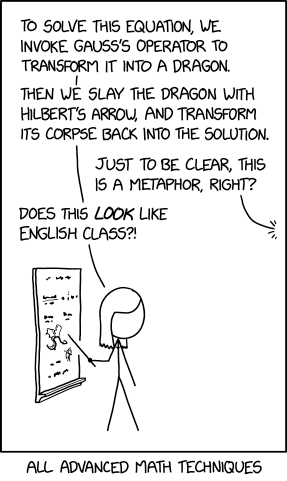Mathematical Foundations of Machine Learning
Prof. Matthieu Bloch
Wednesday September 4, 2024 (v1.2)
Last time

- Last class: Wednesday August 28, 2024
- We talked about the notion of completeness
- We talked about the orthogonal projection theorem
- We proved it in infinite dimension
- We explicitly used the notion of completeness in our proof
- To be effectively prepared for today's class, you should
have:
- Gone over last week's slides and read associated lecture notes
- Turned in Homework 1
- Started looking at Homework 2
Computing approximations
- The orthogonality principle gives us a procedure for computing the closest point
Let \(\calH\) be a Hilbert space, \(\calT\) be a subspace of \(\calH\) with dimension \(n\), and \(x\in\calH\). Let \(\set{e_i}_{i=1}^n\) be a basis for \(\calT\). Then the projection \(\hat{x}\) of \(x\) onto \(\calT\) is \[ \hat{x} = \sum_{i=1}^n\alpha_i e_i \] where \(\bfalpha\eqdef\mat{c}{\alpha_1&\cdots&\alpha_n}^\intercal\) is the solution of \(\bfG\bfalpha=\bfb\) with \(\bfG\) the Gram matrix of the basis and \(\bfb\) the coordinates of \(x\) on the basis.
Orthobases
A collection of vectors \(\set{v_i}_{i=1}^n\) in a finite dimensional Hilbert space \(\calH\) is an orthobasis if
- \(\text{span}(\set{v_i}_{i=1}^n)=\calH\);
- \(\forall i\neq j\in\intseq{1}{n}\,v_i\perp v_j\);
- \(\forall i\in\intseq{1}{n} \,\norm{v_i}=1\).
- Notes
- If the last condition is not met, this is just called an orthogonal basis
- Orthobases are useful because we can write \(x=\sum_{i=1}^n\dotp{x}{v_i}v_i\) (what happens in a non-orthonormal basis?)
- We would like to extend this idea to infinite dimension and happily
write \(x=\sum_{i=1}^\infty\dotp{x}{v_i}v_i\)
- We have to be a bit careful
- With a little bit of machinery, this works: separability + completeness
What we know works in infinite dimension
- Consider a Hilbert space \(\calH\).
The following notions we encountered work without problems:
- Norm induced by inner product
- Cauchy-Schwartz inequality
- Orthogonality + Pythagorean theorem + projection theorem
A collection of vectors \(\set{v_i}_{i\in\calI}\) in a Hilbert space \(\calV\) is orthonormal if
- \(\forall i\neq j\in\intseq{1}{n}\,v_i\perp v_j\);
- \(\forall i\in\intseq{1}{n} \,\norm{v_i}=1\).
- Notes
- We do not even require \(\calI\) to be countable at this stage.
- We are not saying anything about this being a basis
Towards orthobases in infinite dimension
Let \(c\in\calH\) and let \(\set{x_n}_{n\geq 1}\) be a sequence of vectors in \(\calH\) that converges to \(x^*\in\calH\). Then \(\lim_{n\to\infty}\dotp{x_n}{c} = \dotp{x^*}{c}\)
Let \(\set{v_n}_{n\geq 1}\) be a sequence of orthonormal vectors in \(\calH\). Then for any \(x\in\calH\), \(\sum_{n=1}^\infty\abs{\dotp{x}{v_n}}^2\leq\norm{x}^2\).
The following properties of a countable orthonormal set \(\set{e_i}_{i\geq 1}\) are equivalent:
- Finite linear combinations of elements in \(\set{e_i}_{i\geq 1}\) are dense in \(\calH\);
- If \(v\in\calH\) and \(\forall j\geq 1\) \(\dotp{v}{e_j}=0\) then \(v=0\);
- If \(v\in\calH\) then \(\sum_{i=1}^n\dotp{v}{e_i}e_i\) converges to \(v\) (in the norm \(\norm{\cdot}\)) as \(n\to\infty\);
- If \(v\in\calH\) and \(\forall k\) \(a_k\eqdef \dotp{v}{e_k}\) then \(\norm{v}^2=\sum_{k\geq 1}\abs{a_k}^2\).
- This does not say anything about the existence of such a nice orthornormal set
Separable space
A space is separable if it contains a countable dense subset.
- Separability is the key property to deal with sequences instead of collections
Any separable Hilbert space has an orthonormal basis.
- Many useful Hilbert spaces are separable! We won't worry about non-separable Hilbert spaces
- Key take away for separable Hilbert spaces
- \(x=\sum_{i=1}^\infty\dotp{x}{v_i}v_i\) is perfectly well defined for an orthonormal basis
- Parseval's identity tell us that \(\norm{x}^2=\sum_{k\geq 1}\abs{\dotp{x}{v_k}}^2\).
- We don't need to even worry about the nature of \(\calH\) and only think about coefficients \(\dotp{x}{v_i}\)
Any separable Hilbert space is isomorphic to \(\ell_2\)
Next time
- Next class: Monday September 9, 2024
- We will talk about orthobases
- We will prove a fundamental result called Parseval's theorem
- To be effectively prepared for next class, you
should:
- Go over today's slides and read associated lecture notes
- Work on Homework 2 (due date: Friday September 13, 2024)
- Optional
- Export slides for next lecture as PDF (be on the lookout for an announcement when they're ready)